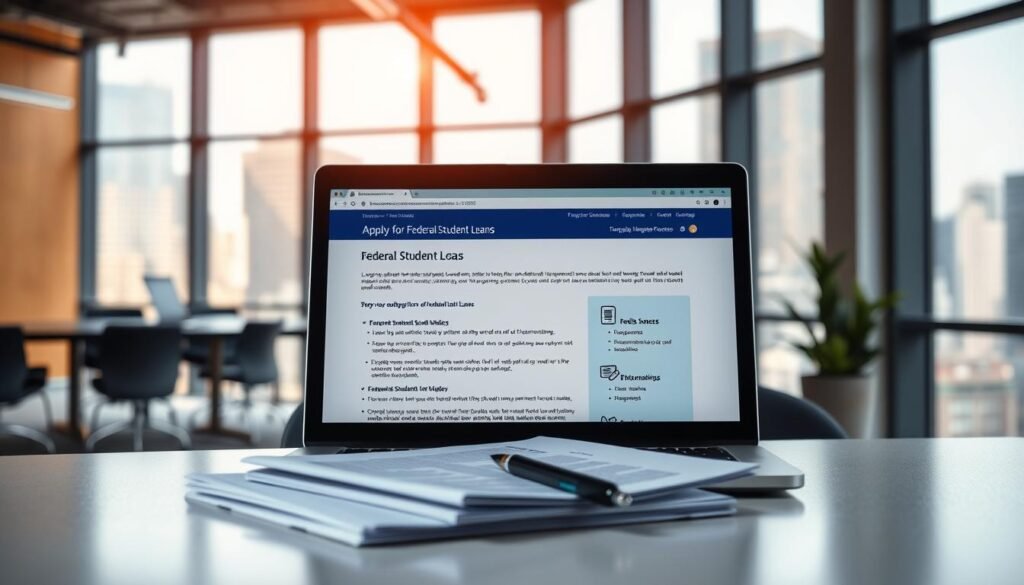
Guide to How to Apply Federal Student Loans USA

Picture this: you open an email and see your FAFSA summary. Your heart skips a beat. The numbers show grants, work-study, and a clear path for aid. That moment changes your plan for college.
Federal student programs often arrive first in an aid package. They offer flexible repayment and income-driven plans without a steep credit check. That makes them easier for many families.
In this short guide, you’ll learn the free application steps and what to expect after filing. Schools use your form to build an award letter with grants and loan options. You’ll also see limits for undergrads and grad borrowers and when private student loans might help.
Ready for the next step? Start by creating an FSA ID and then visit this resource for a clear view of timelines, borrowing caps, and repayment basics.
- Start here: What federal student loans are and why they’re your first option
- Check your eligibility before you apply
- How to apply federal student loans USA
- Understand how your aid is calculated: SAI, COA, and need
- Compare your financial aid offers the smart way
- Know your federal loan options
- PLUS loans, credit checks, and what to do with adverse credit
- Loan limits and how much you can borrow
- Interest rates, capitalization, and how costs add up
- Repayment plans and forgiveness options you should know
- If federal aid isn’t enough: using private student loans wisely
- Your action plan for paying for college today
Start here: What federal student loans are and why they’re your first option
Start here: get a clear view of the loan types you’ll see in an aid offer and why they usually come first.
The William D. Ford Federal Direct program issues the main options: Direct Subsidized, Direct Unsubsidized, and Direct PLUS. These federal student loans come with standardized protections set by the U.S. Department of Education.
Subsidized loans pause interest while you study at least half-time and during deferment. Unsubsidized loans accrue interest during all periods, so interest can grow before repayment starts.

Why pick these first? Federal loans typically have low, fixed interest rates and flexible repayment plans that can adjust with your income. Private student loans often use variable rates, require a credit check, and lack federal repayment protections.
PLUS loans serve parents and grad borrowers, may need a credit check, and can cover up to cost of attendance minus other aid.
- Federal Direct offers clear terms and borrower shields.
- Private student options are often a fallback if federal aid is exhausted.
For context on budget and timelines, see this brief note on potential funding interruptions in government operations at what happens during a shutdown.
Check your eligibility before you apply
A quick eligibility check saves headaches later verify school, program, and status first.
Confirm school and program participation. Your college must take part in the Direct Loan Program and your program must lead to a degree or certificate. Without both, federal student aid won’t be available.
Enrollment level matters. You must be at least half-time to get Direct Subsidized or Direct Unsubsidized loans and to keep in-school benefits. Check your school’s half-time definition—credit hours or clock hours can differ.

Undergraduates who show financial need may qualify for Direct Subsidized funds. Undergrad and graduate professional students can get Direct Unsubsidized funds regardless of need.
- FAFSA determines your financial need and schools may adjust figures for campus-based aid.
- Keep documentation ready: citizenship or eligible noncitizen status and proof of academic progress.
- Transfers, certificate tracks, or reduced enrollment can change eligibility notify your financial aid office right away.
Want more on financing options for distance learning? See this guide on online scholarships and distance learning for helpful next steps.
How to apply federal student loans USA
Create a clear plan before you start. Create your FSA ID, gather tax records, Social Security numbers, W-2s, and any records of untaxed income. Keep parent documents handy if you’re a dependent.

Create your FSA ID and gather documents
Create an FSA ID at StudentAid.gov so you can securely sign and manage your account. Store your login details where you can find them for renewal filing.
Complete the Free Application for Federal Student Aid (FAFSA)
File the free application online for the fastest turnaround—processing is usually 3–5 days. You may mail a paper FAFSA, but expect about 7–10 days for processing.
Submission timing and processing windows
Submit the FAFSA each year you’re enrolled. Schools use your submission to build award offers that can include federal student loans, grants, and work-study.
"Completing the FAFSA does not obligate you to borrow; it only determines eligibility for various forms of student aid."
- List every college you’re considering so each can access your FAFSA data.
- Watch for your FAFSA Submission Summary and correct errors quickly.
- Meet priority deadlines to maximize campus-based aid access.
- After offers arrive, accept, reduce, or decline loans and finish entrance counseling plus a Master Promissory Note as required.
Understand how your aid is calculated: SAI, COA, and need
Know the math behind your package so you can compare offers with confidence.
The FAFSA produces a Student Aid Index (SAI). This number estimates what you and your family can contribute for the year.
Schools use the SAI as the baseline when building your financial aid package.
Cost of Attendance (COA): tuition, fees, room and board
Cost attendance is the school’s full budget for one year. It includes tuition, mandatory fees, room and board, books, supplies, and typical travel or personal costs.
Each college sets its own COA, so budgets vary widely between campuses.
"Your financial need equals COA minus SAI, and that calculation drives need-based assistance."
That difference COA minus SAI shows your financial need. Need-based aid may include Pell Grants, work-study, and subsidized loans.
If your SAI is higher, you may still access unsubsidized options and other student loans not based on need.
- Check each school’s COA on its financial aid website to sanity-check award letters.
- Ask the aid office about special COA allowances for dependent care or disability costs.
- Use SAI and COA estimates to project multi-year costs and plan any out-of-pocket gaps.
Compare your financial aid offers the smart way
Open every award letter and look for the pieces that affect cash now and debt later. Focus first on grants and scholarships that never require repayment. Those reduce your real cost immediately.
Reading award letters: grants, work-study, and loans
Line up offers from each school and separate free money from work-study and any funds you'll repay. Work-study pays as you earn it and isn't an automatic offset for tuition.
Tip: Use net price subtract grants and scholarships from COA so you compare true cost, not sticker price.
Prioritizing subsidized vs. unsubsidized loans
Give top priority to Direct Subsidized Loans when eligibility is based on financial need. The government covers interest while you study and during grace periods.
Evaluate Direct Unsubsidized Loans next; they accrue interest at all times, so small in-school payments can lower long-term costs.
- Compare interest rates and repayment terms across offers.
- Look for fees, renewal rules, and aid tied to GPA or credits.
- Only consider private student loans after you exhaust federal options and confirm the private terms are better.
"Prioritize grants first, subsidized loans second, and keep borrowing only what you must."
Know your federal loan options
Understanding each federal option helps you borrow smarter and limit future interest. Below are the three main federal direct programs you’ll see on an award letter and what each one means for your balance over time.
Direct Subsidized Loans for undergraduates
Direct Subsidized funds are for undergraduates with demonstrated financial need. No interest accrues while you’re enrolled at least half-time, during deferment, or in the six-month grace period.
This makes subsidized loans the most affordable federal borrowing option for eligible students.
Direct Unsubsidized Loans for many borrowers
Direct Unsubsidized funds are available to undergraduates and graduate professional students regardless of need. Interest is charged at all times and may capitalize if unpaid.
Making interest payments while enrolled can lower your long-term cost if you can.
Direct PLUS Loans for parents and grads
Direct PLUS loans serve parents of dependent undergraduates and graduate or professional students. Eligibility isn’t based on financial need, but a credit check is required.
PLUS can cover up to the school’s cost attendance minus other aid. Use it only when subsidized or unsubsidized amounts don’t meet your budget.
"Mix subsidized and unsubsidized funds first, then consider PLUS if gaps remain—watch capitalization and total borrowing against expected income."
- Read award letters using the exact program names: Direct Subsidized, Direct Unsubsidized, Direct PLUS.
- For loans graduate or private graduate options, compare terms carefully — see this guide on private loan options for graduate students.
PLUS loans, credit checks, and what to do with adverse credit
Parents and graduate professional students often turn to direct plus loans when grant aid and unsubsidized options fall short. These programs let you borrow up to the school's cost of attendance minus other aid.
Credit check basics: a credit check looks for recent defaults or serious delinquencies. If your credit history shows adverse items, you must meet extra steps before approval.
- Show documented extenuating circumstances or add an endorser to pass the credit check.
- Complete required counseling when an adverse credit decision needs review.
- Interest on direct plus begins accruing immediately and may capitalize later.
"If an application is denied, the student may access higher unsubsidized limits or explore private alternatives."
Comparing common options
| Option | Who borrows | Key features |
|---|---|---|
| Parent PLUS | Parents of dependent undergrads | Credit check, covers up to COA minus other aid, interest accrues |
| Graduate PLUS | Professional students and grads | Extends funding beyond unsubsidized, credit check required |
| Private alternative | Student or cosigner | May need strong credit, variable protections, compare costs |
Loan limits and how much you can borrow
Know your borrowing caps so you won't run out of aid before graduation. These federal rules set both annual and lifetime ceilings. Track them now so you can pace borrowing over your degree.
Annual and aggregate limits for dependent students
Dependent undergraduates face an aggregate cap of $31,000 across subsidized and unsubsidized funds. Of that total, no more than $23,000 may be subsidized.
Independent undergraduates and parents not eligible for PLUS
If you’re independent, or a dependent whose parent is ineligible for plus loans, the aggregate cap rises to $57,500. The subsidized portion still tops out at $23,000.
Graduate and professional limits, and using PLUS
For graduate and professional borrowers, the combined cap reaches $138,500. Up to $65,500 of that amount can be subsidized when prior undergraduate borrowing is counted.
Plus loans and Direct PLUS remain an option when unsubsidized amounts and annual limits don’t meet need. PLUS funds may cover up to your cost attendance minus other aid.
- Compare annual grade-level limits with your aggregate totals so you don't exceed availability.
- Confirm your school's cost attendance figures and ask the aid office about any gaps.
- Monitor totals in your federal loan dashboard so you always know how much room remains among the loans available to you.
Interest rates, capitalization, and how costs add up
Interest can change the total you repay far more than the principal you borrow.
Fixed interest rates on federal loans give you predictability. Rates are set each year and do not move. That stability helps when you budget monthly payments and compare offers.
Fixed federal rates versus variable private options
Private student loans often use a variable interest rate that can rise after an intro period. That uncertainty can raise your long-term cost.
Direct unsubsidized funds and PLUS loans begin accruing interest immediately. Unsubsidized student loans charge interest during school and grace periods.
When interest accrues and capitalizes
Capitalization happens when unpaid interest is added to your principal. After that, new interest accrues on a larger balance and your cost grows.
- Tip: Make small in-school interest payments on unsubsidized loans to limit capitalization.
- Compare APRs, fees, and rate types before choosing any private or federal option.
- Use sample amortizations to see how rates and capitalization affect monthly payments and total interest.
"Choosing predictability and repayment protections often saves more than chasing a slightly lower introductory rate."
Repayment plans and forgiveness options you should know
Repayment choices shape your monthly budget and your long-term cost.
Start by reviewing fixed and income-driven options so you can pick a path that matches your income and career goals. Use your federal student aid account to model payments and compare outcomes.
Fixed repayment: Standard, Graduated, Extended
- Standard pays your balance fastest with level monthly payments and the least interest overall.
- Graduated begins with lower payments that rise every two years. It helps if your income should grow.
- Extended spreads payments over a longer term to lower your monthly cost, but increases total interest paid.
Income-driven plans: SAVE, PAYE, IBR, ICR
Income-driven plans set payments based on income and family size and can lead to forgiveness after a qualifying period.
Enroll and recertify income each year, and keep records of your payments. The U.S. Department of Education counts qualifying payments toward forgiveness when rules are met.
Public Service Loan Forgiveness and other discharges
Public Service Loan Forgiveness (PSLF) requires work for an eligible employer, a qualifying repayment plan, and on-time payments. Keep employer certification forms and payment records.
Other discharges or cancellations may apply for disability, school closure, or wrongful certification. Review your options carefully and document everything.
- Use automatic payments for a potential rate discount and consistent on-time credits.
- Consider targeted prepayments to principal when possible.
- If you mix federal student loans and private debt, protect federal benefits first.
| Plan type | Who it helps | Term / outcome | Key action |
|---|---|---|---|
| Standard | Borrowers who can afford higher monthly payments | 10 years, faster payoff | Choose for least interest |
| Income-driven (SAVE, PAYE, IBR, ICR) | Low or variable income borrowers | 20–25 years, possible forgiveness | Enroll and recertify income yearly |
| PSLF | Public service employees | Forgiveness after 120 qualifying payments | Certify employment and save records |
| Extended / Graduated | Those needing lower monthly payments | Up to 25 years, higher total interest | Compare cost versus cash flow |
"Choose a plan that fits your present budget and future plans, and review it yearly."
For recent policy context, see this policy update that may affect repayment timelines and options.
If federal aid isn’t enough: using private student loans wisely
When grants and federal aid fall short, private options can help fill the gap but they carry different rules. Private student loans come from banks, credit unions, and online lenders and use their own applications rather than FAFSA.
Know the trade-offs. Private student loans typically require a credit check and often a cosigner if your credit history is thin. Rates may be variable, and repayment protections are limited compared with federal student loans.
When to consider private options and what to compare
- Use private student debt only after you’ve maxed grants, scholarships, work-study, and federal borrowing.
- Compare APRs, fees, fixed versus variable rate choices, and hardship policies before signing.
- If you’re a graduate professional borrower, weigh PLUS loans against private offers for total cost and flexibility.
Credit, cosigners, and refinancing after graduation
Some lenders evaluate education and earning potential, which helps borrowers with limited credit. A strong cosigner often secures better terms.
"After graduation, refinancing can lower interest rates, but it removes federal protections and consolidation options."
Borrow only what you need to pay college costs, track each loan servicer, and plan payments against your expected starting salary.
Your action plan for paying for college today
A small checklist today can keep you from borrowing more than you need later. Start early, gather tax and income records, and submit the FAFSA well before deadlines to boost your chances for strong financial aid.
Compare offers by net price. Favor grants and scholarships first, then subsidized funding, then unsubsidized and PLUS only if necessary. Track your SAI against each school's COA and build a semester budget that limits borrowing.
Finish entrance counseling and sign your Master Promissory Note for any federal student funds you accept. If a gap remains, weigh private options carefully and choose the lowest-cost amount to pay college bills.
Make small in-school interest payments on unsubsidized balances when possible. Pick a repayment plan before you graduate, set up autopay, and revisit your plan each year. For extra guidance on scholarships and saving, see the student aid guide.
Keep your eye on the degree outcome. Stay on track academically and financially so your investment helps you pay college with manageable, planned debt.
If you want to know other articles similar to Guide to How to Apply Federal Student Loans USA you can visit the category Loans.






Leave a Reply